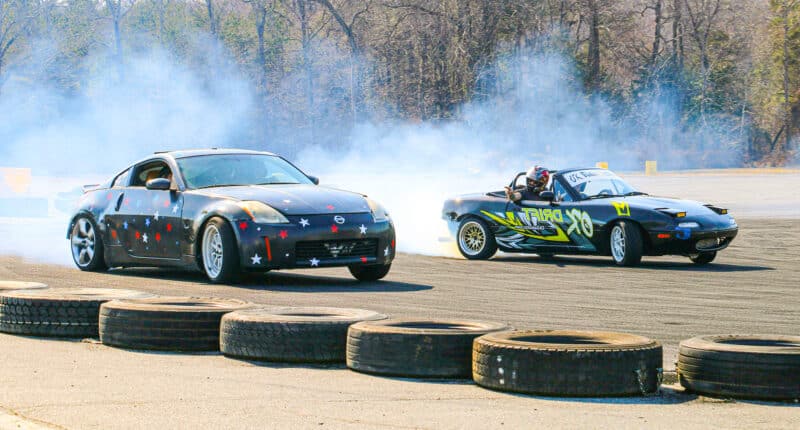People love buying old Japanese cars because of their bargain price, excellent performance, and low cost of ownership. Ask any enthusiast who has a project car and there’s a high chance it’s going to be JDM.
Today we’re pitting two of the most well-received JDM cars against each other. These two are polar opposites in terms of their development, design language, and overall driving characteristics.
We’re talking about the ever-popular Nissan 350z and the Mazda Miata.
The latter follows in the footsteps of Colin Chapman—the revered saint of minimalism whose mantra was “to add speed, add lightness”. While the other is a generously powered drift missile that promises affordable performance and loves going sideways.
Read on as we compare the two odd adversaries. In this guide, we’ll explore which is the better car in terms of handling, reliability, specs, ownership costs, and more. Let’s dive right in.
Mazda Miata
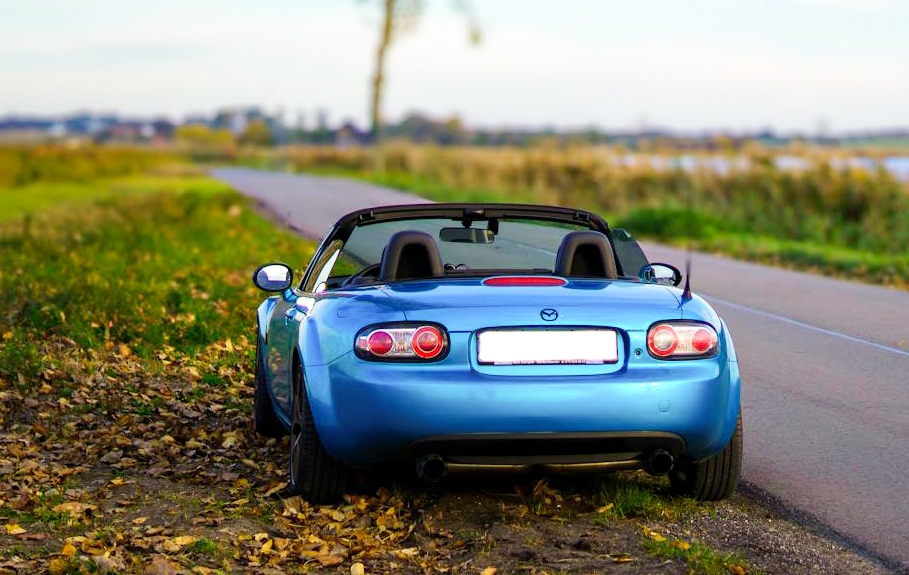
When enthusiasts first got their hands on this go-kart-like roadster, they experienced the sheer joy the Miata exuded on the tarmac despite its low-performance figures. It felt like a motorcycle, and that’s saying something.
A few years ago, the NA and NB Miata was the biggest bargain out there as they were at the lowest point of their depreciation curve. Soon it was everywhere, be it the tracks, the roads, or motorsport events.
The concept developed by Bob Hall and the American division of Mazda took inspiration from the Lotus Elan, which was a light, affordable roadster during the ’60s.
Mazda’s board favored the American design over the one developed by the Japanese team.
Thus, the base for the Mazda Miata we know today came from the United States of America. Let’s explore the rich history of this humble little roadster.
1989-1998 First Generation (NA)

The first-gen Mazda Miata was easily recognizable thanks to the pop-up headlights and a clean, minimalistic soft-top. It also featured slim chrome door handles and a very approachable stance as opposed to the mean-looking muscle cars popular at the time.
It quickly became the unmistakable British-inspired roadster with Japanese build and reliability.
In its initial years, the Miata was available only with a 1.6-liter engine that produced 116 hp with no power steering or power brakes to keep the weight down.
After a few years, in 1994, Mazda launched a beefed-up 1.8-liter engine churning 128 hp, which became the standard in most markets.
Not only did the upgraded 1.8-liter variant offer stiffer chassis for improved balance and dynamics of the Miata, but it also featured the much-needed Torsen-style limited-slip differential.
To date, the 1.8 version of the NA Miata MX-5 remains the most sought-after variant.
1998-2004 Second Generation (NB)
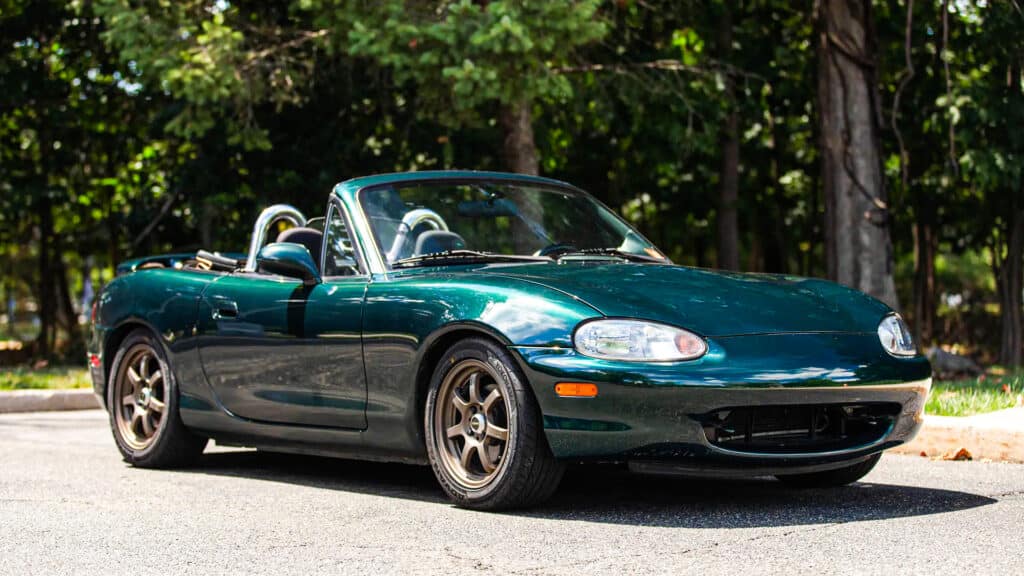
The second-generation or NB Miata MX-5 received a few cosmetic changes like the pop-up headlight delete to meet revised safety standards but retained the physical dimensions of the NA Miata.
If, for whatever reason, you dislike the look of pop-up headlights, you can always consider going in for a Miata headlight conversion kit on the NA.
Apart from the dimensions, the powerhouses were also carried forward in the engine bay. However, the 1.8-liter engine now generated 140 hp, and the 1.6-liter motor was rated at 116 hp like the previous generation.
The NB performed better than the NA due to its great platform that concocted better balance and power. Also, NA Miatas are very sought after, making the NB a more affordable deal that fits into a tight budget.
A special edition of the Miata called the Mazdaspeed received factory forced induction in the form of a turbocharger installed on the 1.8 engine to churn a mighty 178 horsepower rating. It also featured 17” wheels for better aesthetic appeal.
If you like the idea of forced induction, know that there are many aftermarket supercharger kits for the Miata that you can choose from.
2005-2015 Third Generation (NC)
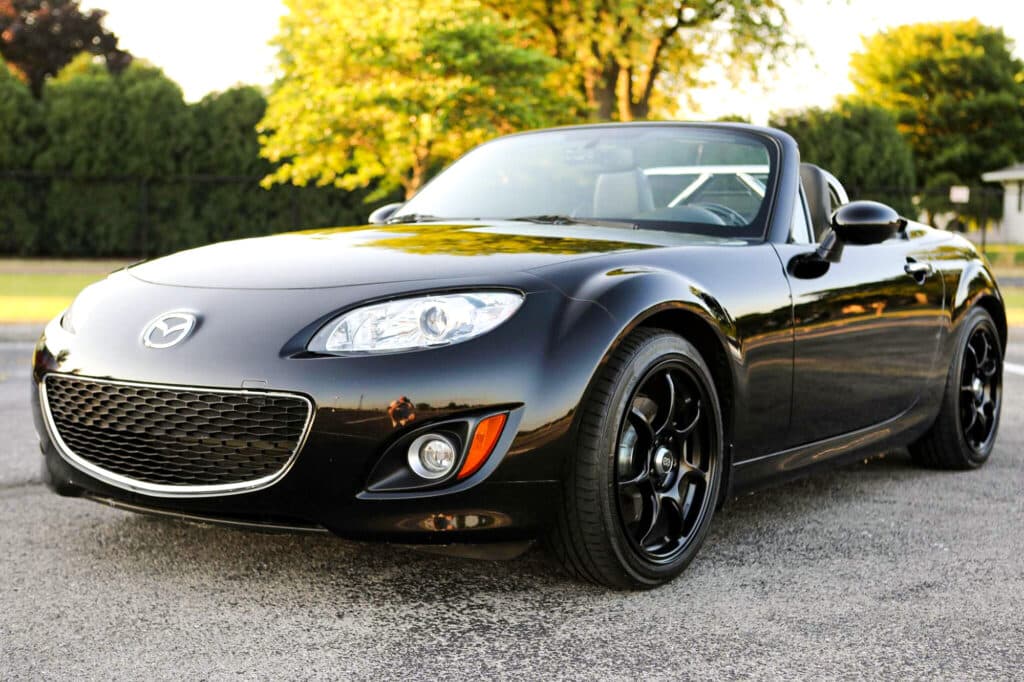
The third-gen or the NC Miata is the family’s black sheep because of its heavy frame. It remains the heaviest production Miata to date. It also featured a new 2.0-liter engine that pushes roughly 167 hp, making it more powerful than its predecessors.
Another notable addition was the retractable power hard-top, which made it suitable for driving in all-year-round weather. The soft-top became challenging to maintain and use during rain and snow.
However, the hardtop was not appreciated by many enthusiasts who found it redundant.
Later in 2009, the Miata NC received a facelift that featured updated front and rear bumpers along with new side skirts.
Mazda also updated the transmission, suspension, and engine. The cosmetic changes made the Miata NC look more in line with the other products from Mazda.
2015-Present Fourth Generation (ND)
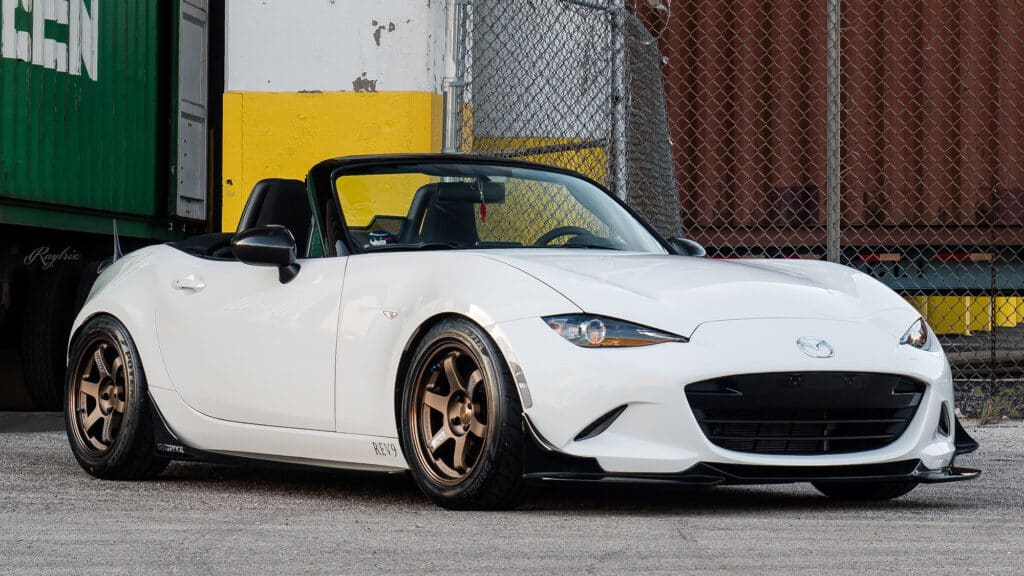
All the older gen Miatas are labeled as cute-looking sports cars, but the ND looks more aggressive and it means business. It has two engine options, the 2.0-liter four-pot making 155 hp and a smaller 1.5-liter engine making a healthy 129 hp.
The low power is justified with a reduction of almost 220 pounds, making it the fastest Miata produced in the factory.
In 2019, the Miata ND received a refresh in the form of a facelift and a more robust powertrain. The 2.0-liter engine made 181 hp with a higher redline.
The engine now revved up to 7,500 rpm compared to the 6,700 rpm in the pre-facelift versions. In terms of new equipment, it featured a new telescopic steering column and a reverse parking camera as standard.
Nissan 350z
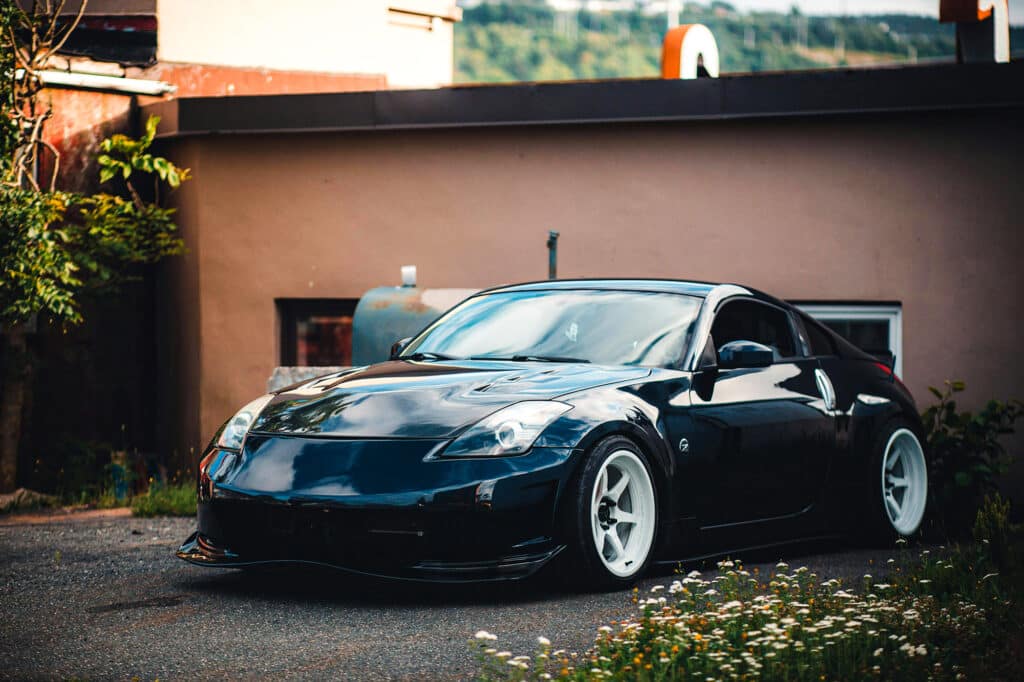
The Nissan 350z is now officially in its angsty teenage years, and to say that it has depreciated well is an understatement. That explains why it’s the younger enthusiasts that flock towards it.
We have no doubt that anyone and everyone looking for capable tuner cars and drift cars on a budget most certainly have the Z33 on their mind.
Nissan’s over-engineered VQ engine is extremely dependable. The car has a beautifully balanced chassis that’s rigid enough for experts and novices alike.
Due to the massive aftermarket support, easy availability of parts, top-notch performance, and a tuner-friendly V6 engine, the 350z remains atrociously popular among enthusiasts of all walks and beliefs.
The sheer number of ways in which you can modify your 350z is limitless; it is a great daily driver, track car, drift car, stance car, and spacecraft (a better choice than a Pontiac Fiero from Fast and Furious 9).
If this is going to be your first car, you might want to learn how to modify a car properly.
2003-2006 First Gen
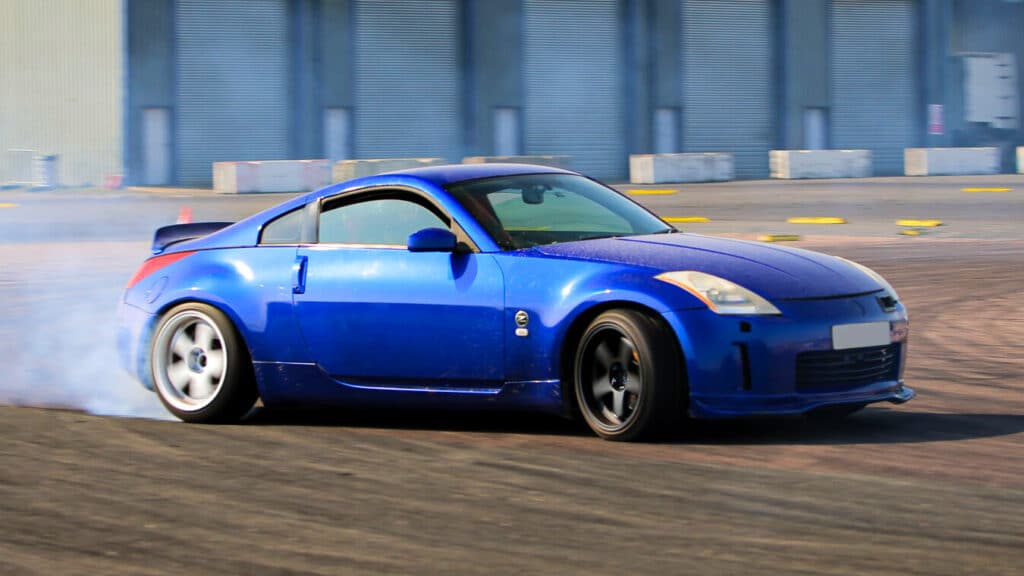
The Nissan 350z created a buzz everywhere, as it was Nissan’s answer to the big muscle car. Unlike its bulky muscle counterparts, the 350z could turn, steer, and attack corners like nobody’s business.
It had all the right things going for it. Features like the unique teardrop design, powerful V6 engine making 287 hp, and a stable platform made it an instant success for Nissan.
However, keen enthusiasts were quite unhappy with the car’s weak low-end power, the naturally aspirated V6 engine’s irritatingly low redline.
2007-2009 Facelift
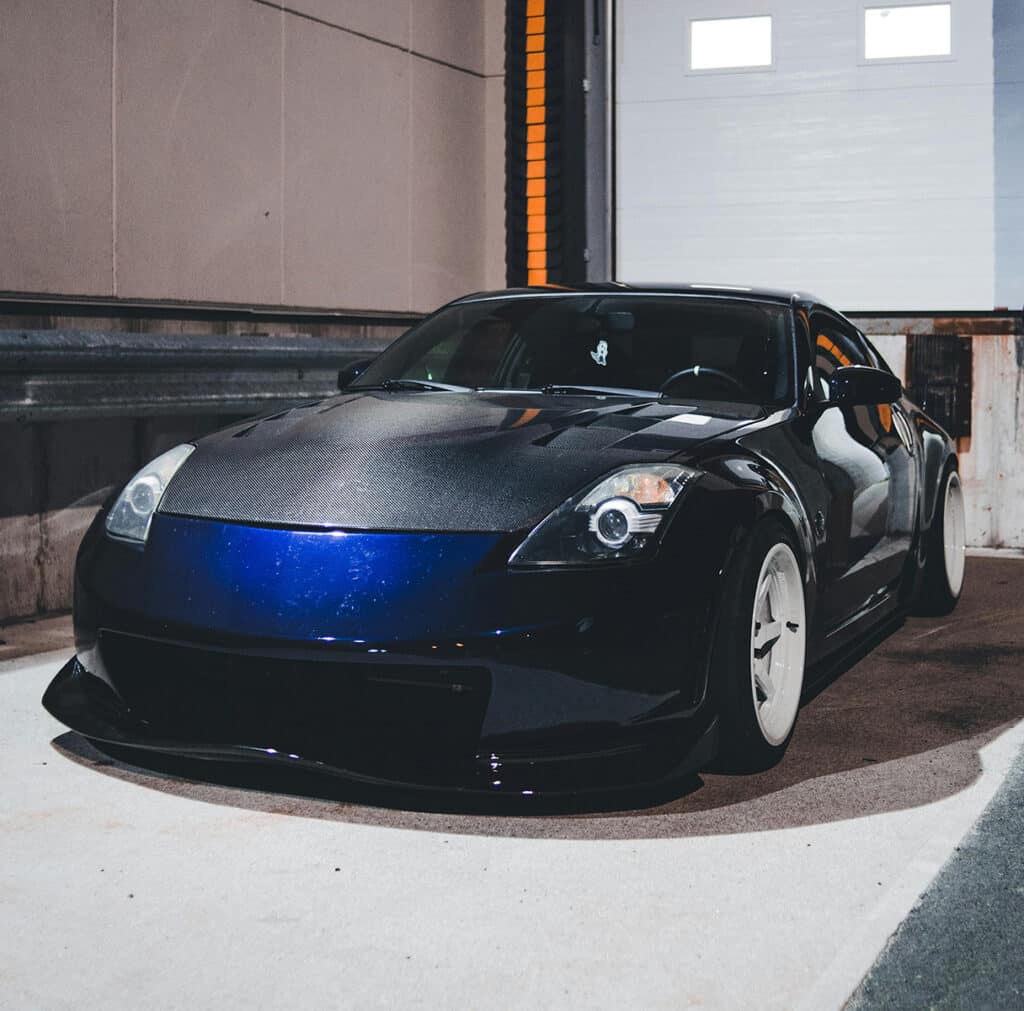
Soon, Nissan answered the jury with the refreshed 350z that featured a much better version of the V6 engine along with a battery of crucial design updates.
The VQ35DE engine was upgraded to VQ35HR and was tuned to produce 90% of its torque under 2000 rpm with a healthy output of 306 hp. Sounds wicked.
Even though 80% of their parts aren’t interchangeable, both engines run very similar quarter-mile times. We have no doubt that the HR engine was built better—it revved more freely than before and redlined at 7,600 rpm.
It also achieved peak performance sooner than the older motor, making it the car of choice for many enthusiasts. Not just that, but the emissions were also lower than the older version.
Maintenance and Reliability
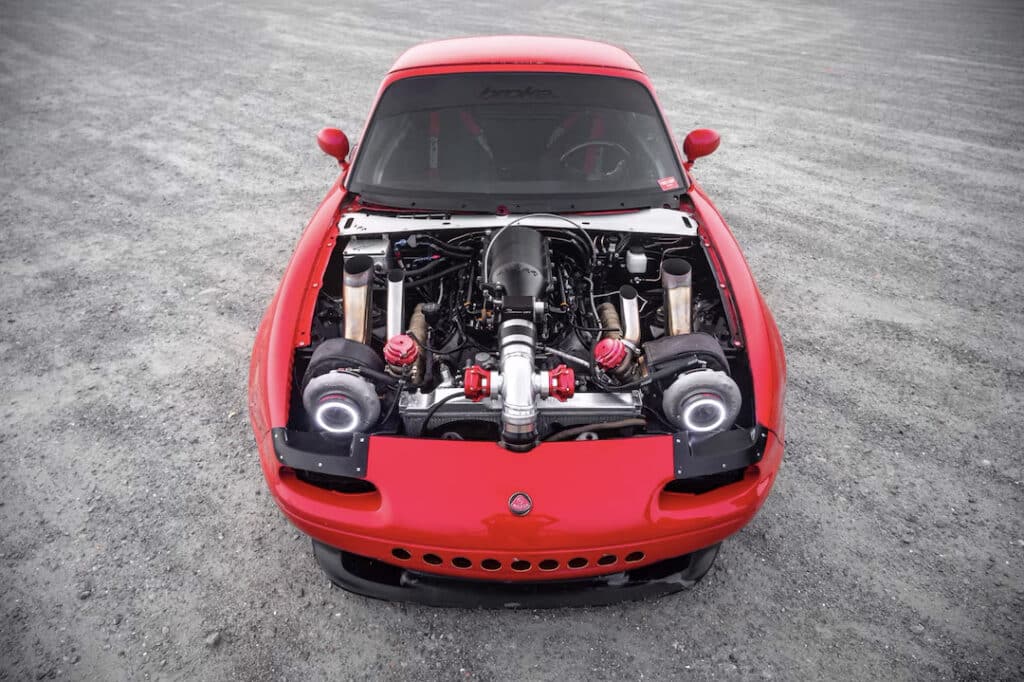
We’ve come across several well-maintained Miatas that have clocked over 500,000 miles and still run like a charm. However, the engine will outlive the exterior of the car.
Considering how old the NA and NB Miatas are, they inevitably suffer from severe rusting issues.
It’s not just the Miata that has issues. Even the 350z has a variety of flaws. The major drawback is with the first-gen 350z, which has a lot of timing belt issues and other engine-related failures that need to be checked from time to time.
Other issues include but are not limited to low engine oil pressure, radiator fan failure, headlight failure, and differential bushes going soft.
As we have said in our other guides before, these cars are in no way new (except the ND Miata). They’ve likely seen a lot of abuse from previous owners. Overall, the Miata takes the bigger piece of the pie when it comes to maintenance and reliability.
Which Car Handles Better?
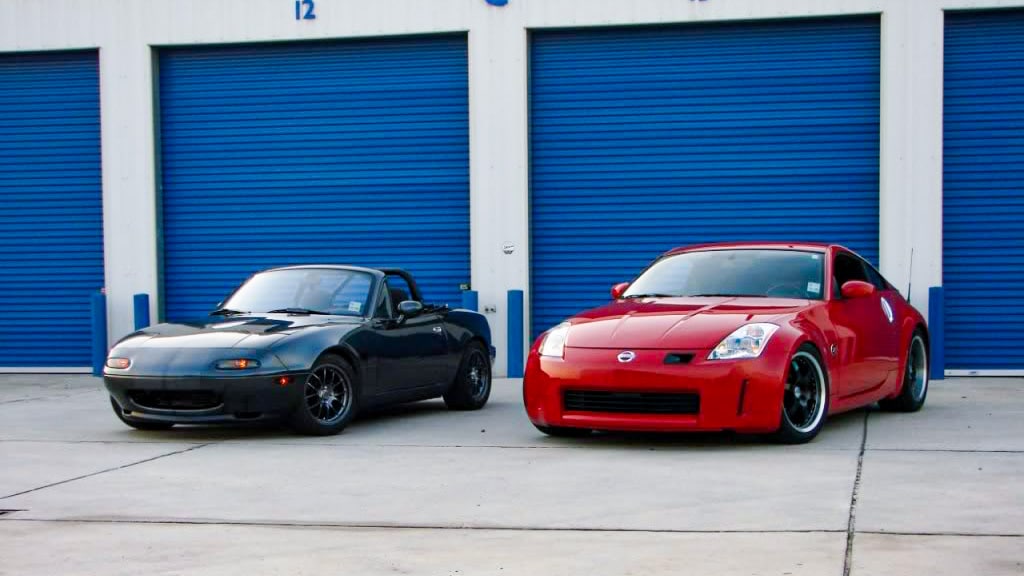
This one’s a no-brainer—the Miata is clearly the better car when it comes to handling. Mazda engineers treated this car like how Michael Angelo treated his paintings. It was painstakingly designed to handle flawlessly, and it does just that.
Mazda ensured that the Miata can be adopted by novices and experienced track-guys alike. It’s easily approachable and is a great platform to learn on and even daily drive. We can’t say the same about the 350z, especially when it’s up against the Miata.
That’s not to say that the 350z is a bad car. Oh no; this thing is no slouch. If you want the “pushed back in the seat” feeling, then this is the one to go for.
The chassis is commendable, and it can withstand rigorous driving conditions all day. There’s a reason why it’s a staple at many motorsport events.
The Miata is more composed in the corners and can easily attack hilly hairpins. In contrast, the 350z requires the driver to have tremendous control, as one heavy blip on the gas can cause you to oversteer at a challenging corner.
Which Is a Better Track Car?
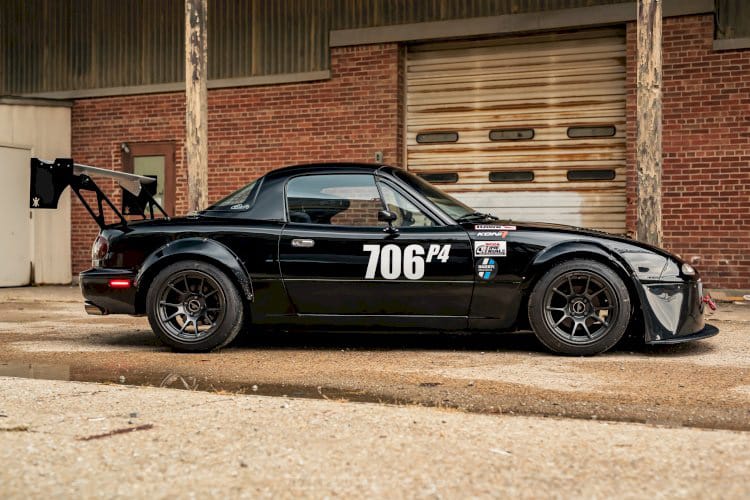
As for which one’s a better track car, it’s going to be a tie between the two, unless you blatantly prefer one over the other. Technically, neither of these was designed exclusively for the track. It’s a street-first, track-second situation with the two.
Converting any passenger car into a proper track car requires time, patience, skills, and resources.
The Mazda is a lot easier to work on in comparison with the 350z, so there’s that. It’ll break down less often. Modifying the Miata is easier too. All kinds of car parts are readily available, and it has a respectable aftermarket community backing it up.
But if you hop into a 350z right after doing a lap in the Miata, the difference is going to be extremely noticeable, to say the least. The Miata won’t give you high-speed enjoyment at long straights; it comes alive in the twisties and canyons where it belongs.
Which Is a Better Drift Car?
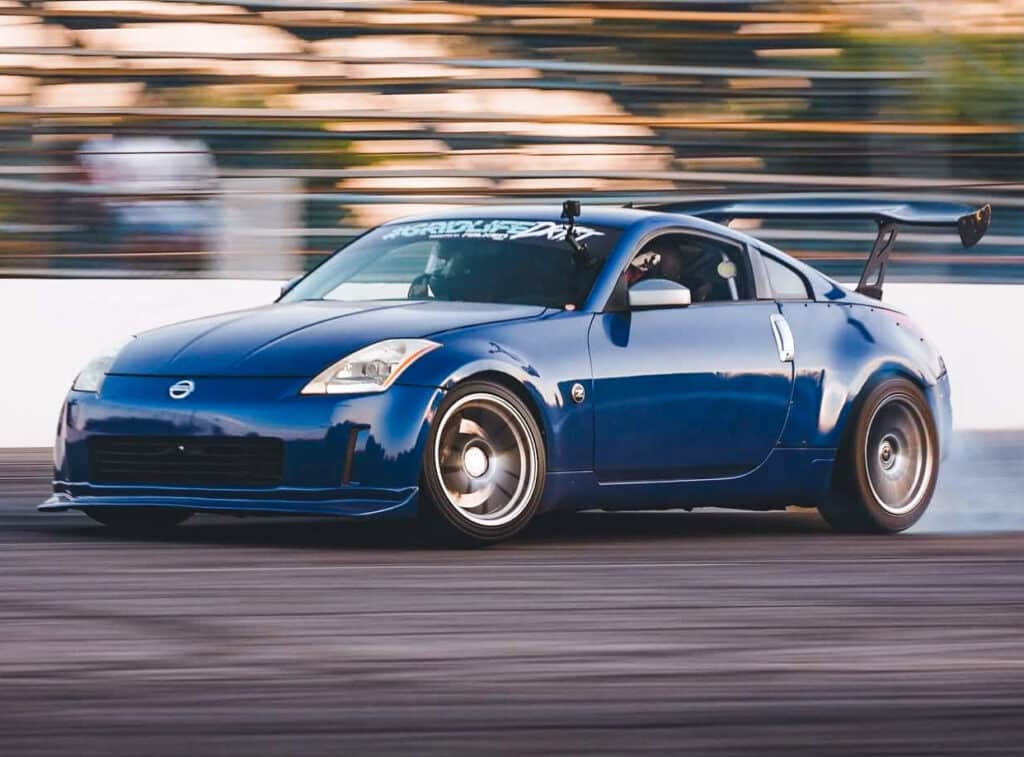
Another no-brainer—the 350z clearly outclasses the Miata when it comes to drifting. If you can drift a Miata, you can drift anything. Because of its short wheelbase and underpowered nature, it’s extremely difficult to control the slip angle while drifting.
All that extra torque in the 350z and its long-ish wheelbase makes it a cakewalk to drift. That’s why most people who get into drifting choose the 350z as their first car.
Apart from the 1.6-liter NA Miata, all its other variants featured a limited-slip differential, making the 1.6-liter NA the least favorable choice as a drift car. On the other hand, the Nissan 350z featured a standard limited-slip diff.
A limited-slip differential is necessary to have better control while drifting. For more clarity, check out our article on choosing the best drift cars.
Which Is a Better Project Car?
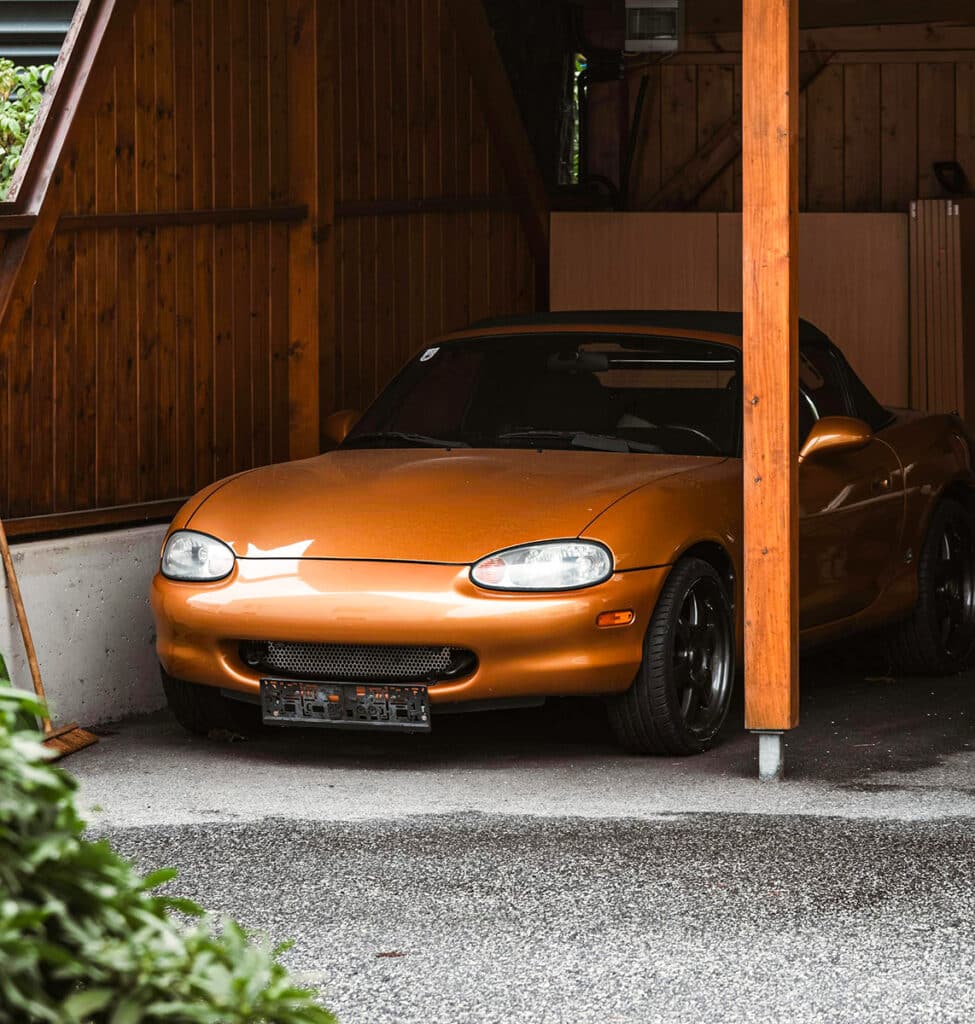
These cars have massive aftermarket support and are relatively easy to work on by yourself. There is no winner here, as each holds its own. It is more of a personal choice; someone who likes the Miata won’t necessarily be swayed by the 350z and vice versa.
Whether you want a new daily driver, a new project car to learn the mechanics of a vehicle, or just something to enjoy track days with, the Nissan 350z, and the Mazda Miata are both equally qualified candidates.
But just like in every race, there can only be one winner.
Miata vs 350z: Our Verdict
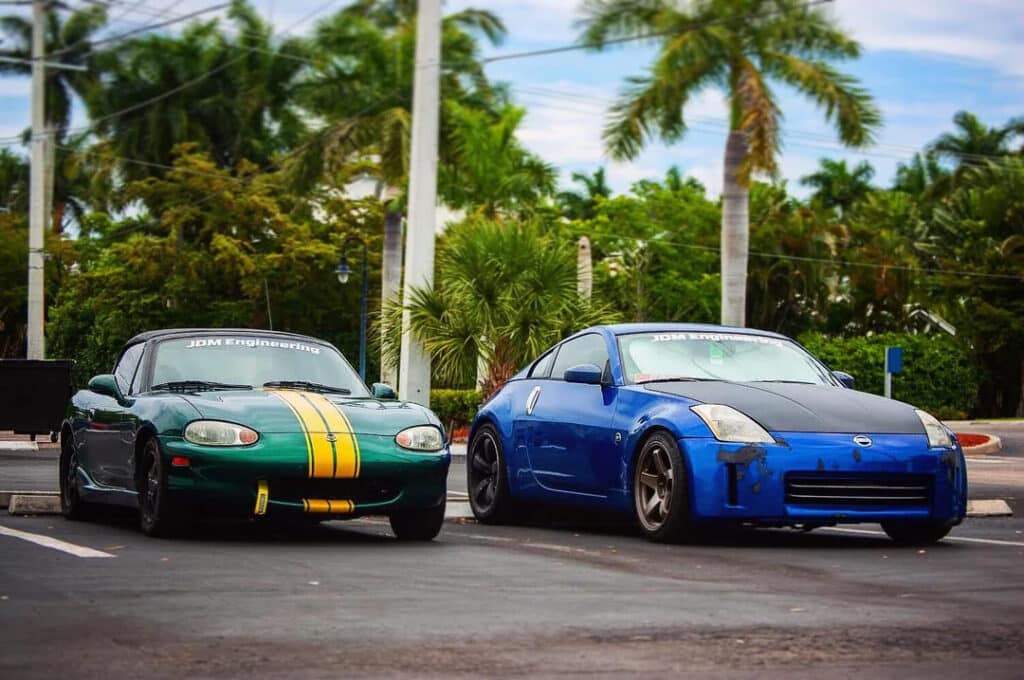
Pitting the Miata against the 350z is like comparing apples to oranges. Both are brilliant cars in their own right, but they do things very differently.
The Mazda is more playful, requires more skill to drive properly, let alone drift properly. Its raw, go-kart-like appeal plasters an ear-to-ear grin on the faces of everyone who drives it.
Nissan’s 350z, on the other hand, has a lot more power, looks better, is arguably easier to modify, and it’s the ideal car to get into drifting with. It’s a great project car. But in the handling department, it just doesn’t compare to the Miata.
Which one do you prefer and why? Let us know by leaving a comment below!
